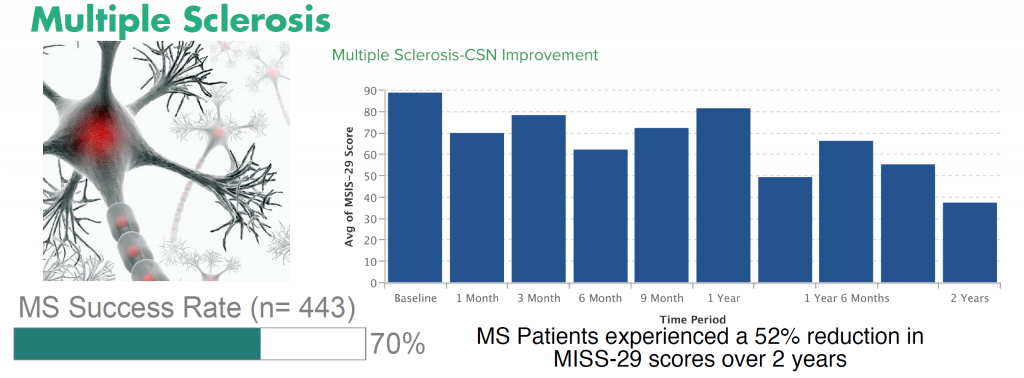What is Multiple Sclerosis?
Multiple sclerosis, or MS, is an autoimmune disease of unknown cause. MS causes the immune system to attack the myelin sheath, the protective covering of the nerves of the brain and spinal cord. You can think of this coating as the insulation on an electrical wire. It helps keep the nerve impulse moving normally. When the myelin sheath is inflamed by MS it can result in pain, muscle weakness, loss of sensation, muscle spasms, memory loss, and many other spontaneous and unpredictable symptoms. Dr. Johnson gives MS patients some relief from these symptoms through stem cells from fat therapy at Innovations Medical. Stem cells can also slow the progression of the disease. While the symptoms of MS vary widely among patients, there are several common warning signs of the disease.
What are the Symptoms of Multiple Sclerosis?
The symptoms of Multiple Sclerosis (MS) vary widely from patient to patient and can vary even in the same patient over time. While the complete list is quite long, here are some of the common symptoms:
Muscle Weakness
Over 75 percent of MS patients have muscle weakness, according to the National Multiple Sclerosis Society. For most of these patients, this weakness begins in the legs. Along with this weakness, many individuals also experience numbness and tingling. These symptoms develop slowly, and may not be noticed by the patient until later on when they become more severe.
Muscle Pain and Spasms
Over half of patients with MS experience chronic pain and uncontrollable muscle spasms. The pain can involve almost any body area and can be difficult to control with standard medications. Some other patients experience stiffness in their muscles, which may make movement difficult or slow.
Extreme Fatigue
Patients with MS report experiencing sudden, extreme fatigue at the early onset of the disease. This fatigue may last for several weeks, and despite rest, does not improve. It may also go away just as quickly as it developed, leaving patients feeling better for a period of time. The fatigue can be debilitating, leaving patients unable to leave the house for days or weeks at a time. Fatigue can also be difficult to treat.
Vision Problems
Blurred vision, double vision, and loss of vision are all common symptoms of Multiple Sclerosis (MS). This is because the inflammation caused by MS condition impacts the optic nerve. For many multiple sclerosis patients, changes in vision happen very slowly, and may not be noticeable until there is a significant amount of damage done. Others can have a sudden near-complete loss of vision. Some patients only experience visual loss with MS
Bladder Dysfunction
Bladder dysfunction is very common in Multiple Sclerosis (MS) patients. Up to 80 percent of patients afflicted with the condition experience frequent urination and incontinence. Some patients experience low bowel control and other digestive problems, too. Bladder and bowel dysfunction are some of the most debilitating and embarrassing symptoms of MS.
What are the Current Treatments for Multiple Sclerosis?
After years of research, there are some disease-modifying treatments are now available. Although these are often expensive and have some side effects, many patients with relapsing-remitting Multiple Sclerosis (MS) respond well and have fewer relapses. The less common form of MS called progressive Multiple Sclerosis can be primary, meaning from the start of the disease, or secondary meaning progression develops over time. Treatment for progressive MS is also disease-modifying, but there are fewer choices and they tend to be less effective.
How Do You Get Stem Cells to Help Multiple Sclerosis?
We obtain stem cells from the person’s own fat tissue. An area about 6 inches around is numbed, typically around the waist. A syringe is then used to liposuction about 3 tablespoons of fat. See our blogs Understanding Adipose-Derived Stem Cells and What are Stem Cells? Once collected, these stem cells are deployed via IV into the patient. Before the stem cells are given, a drug called mannitol is typically given in the IV. Mannitol has been shown to increase the number of stem cells that can get into the brain. Once deployed, the stem cells go to work to reduce the inflammation of the nerves and repair cells damaged by the disease. Most patients experience improvement in their symptoms as a result of their SVF stem cell therapy, and stem cells may slow the progression of the disease for some individuals. Patients may also see further improvements from repeated treatments.
What are the Results of Using Stem Cells for Multiple Sclerosis?
Innovations Medical and the Cell Surgical network use stem cells obtained from fat to help Multiple Sclerosis. Patients report their results and the results are kept in a common database. The most recent results show 70% of patients respond:
Results of the First 443 Patients Receiving Stem Cells for Multiple Sclerosis

There is an overall reduction in symptoms of 52% in patients receiving stem cells. These patients experience minimal side effects.
Cost of Stem Cell Treatments
The cost of the initial treatment ranges from $5,000 to $10,000. The range in cost is dependent on the complexity of delivering the cells back to you. For example, spine conditions require multiple physicians to deliver the cells back to your body and this requires an increase in cost as multiple doctors are involved in the procedure. For many people the initial treatment is all that is needed; however, for some conditions, subsequent treatments may be required and these are done at a reduced fee.
Innovations Medical provides Stem Cell Therapy procedures at both our Dallas and Fort Worth practice locations. If you think you or a loved one can benefit from stem cell therapy for MS please call our office at (214) 643-8665.

